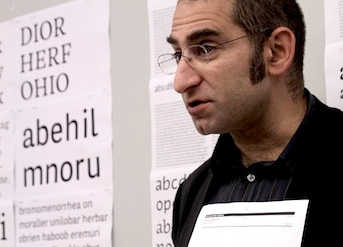Article
ESPI on site: Gerry Leonidas at TYPO London 2012

Gerry Leonidas began his lecture in the Jeffrey Hall with an introduction to the history of typography: How typography is always adapting to changes in technology and different modes of reading. Ranging from text being written by hand in a book or on a wall or on a screen or …

Leonidas summed up: With the invention of print, typefaces adapt to the constraints of the medium. Monochrome becomes the norm because color takes more labour and is therefore more expensive. Different weights and other typographic means try to give meaning and structure to these monochrome documents. At the beginning of industrialization type becomes bolder and louder, fighting for attention of their audiences as their reading behaviors change. Mechanical typesetting solved the bottleneck of manual labour and print becomes more readily available. The start of digital typesetting makes for a collapse of the heavy industry and a change in the role of the type designer now they no longer work for a big technical company. The digital age's unicode and openfont allow typefaces to be ready for the global age and facilitate other scripts beside latin. New digital document structures give rise to new conventions in terms of navigation and the visualization of hierarchy.
Well. We knew some of that before. But it was interesting to see – in a kind of time lapse – the differences and influences between scripts. And just being reminded of some crucial facts, like: Most scripts besides latin don't have an italic. They are just written in one way, not upright and slanted forward mixed together. Or that writing faster leads to a looser style. Armenian for instance does have an upright and a slanted style but they were only being used apart from each other. Under western influence designers are now mixing those up in a way similar to the western use of italic fonts.
Besides being a great lecturer on type history, Leonidas shared his impressive knowledge on typographic development in non-latin scripts. He believes in access to text as a basic human right and typefaces that facilitate that in different scripts are a must for that to happen. His information-dense lecture went into far more details than this innocent bystander is able to reproduce. Plus, it provided some of the political implications type (design) has. Read more on Gerry Leonidas website.
Thanks for contributing to this text to my husband Jerry den Ambtman.